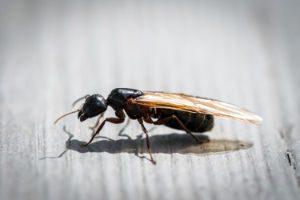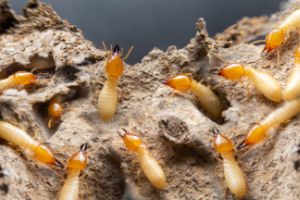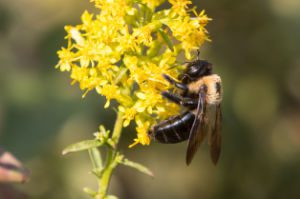Early Summer Insect Activity I
By Zachary Ciras on June 2, 2022.
With Memorial Day just behind us, we have unofficially begun Summer. The official start of summer is a few weeks away, but the insect populations are coming out to play like it’s summertime and the living is easy! The recent hot weekends have really pushed the lifecycles into full drive, and folks all over New England are noticing abrupt activity around (and in) their homes. Everything moves in seasonal cycles around here, and Late Spring/ Early Summer is a season of awakenings and new life emerging!
So that begs the question, what should one enjoy and ignore, and what kind of activity should ring a bell of concern, and ring Colonial Pest (800-525-8084) for help?
Carpenter Ants
The Black Carpenter Ant is, and has been, one of the most destructive pest forces in New England for years. Camponotus Pennsylvanicus takes advantage of structural deficiencies in your home to enter, establish a satellite colony, and builds and expands their nests. Although Carpenter Ants do not gain nutrients from the wood they’re chewing through, these menaces do considerable damage to structural members, trim, insulation, and anything else they can exploit for their own shelter. A mature colony (3-4 years old typically) will produce swarmers to reproduce outside of the colony. In the hot weather, you may see swarmers landing on your deck and home, and you may see ants crawling all around. Keep in mind, these ants are nocturnal, so they level of activity you observe during the day is only a sliver of what’s going on in the dark.

Carpenter Ant Swarmer
To help protect your home, correct any moisture issues you may have. Leaky pipes, basements calling for dehumidification, or standing water near the home may be contributing to an infestation. Also considering cutting back branches and vegetation from the house, storing firewood away from the house and raised off of the ground, and filling in any gaps and cracks which may provide entry to these and other pests.
See ARE CARPENTER ANTS DAMAGING MY HOUSE?
Termites
Another pests which thrives in moist environments, looking to access through small cracks in search of wood material is the Eastern Subterranean Termite. Termite swarmers ( Alates of reticuliterms flavipes) may have already made their appearance to you. Swarming begins earlier in the spring, but the sending out of reproductive termite swarmers may continue into the summer months. These swarmers do not themselves harm or damage your home, but they are an indicator of a mature colony nearby. This colony may be in a stump in your yard, or it may already be in your structure. One of the most dangerous aspects of our Eastern Subterranean Termite is that the species is cryptobiotic. Essentially, this means they work in secret, potentially damaging your home for a significant period of time, without you even knowing it. The swarm may actually be a blessing in disguise, alerting you to an ongoing issue you otherwise wouldn’t have noticed.
 Every year, we visit homes who report a swarm, and then upon a thorough infestation, we discover that the infestation has been ongoing for years. Each year, it is estimated that termites are responsible for about $5B in damage, treatment, and repairs to roughly 600,000 homes! There are some signs to look for, besides the swarm, which can help catch an infestation early before they do thousands of dollars in damage. “Mud” shelter tubes connect the worker termites from the soil to their food source (Wood or anything with wood product -cellulose) in it. Visible damage may be seen just under the paint layer or on the paper facing of drywall. Cracked and water damaged door frames and trim close to the soil may be an early indicator of a termite infestation. On sunny days, you may even find termites warming up under slate, rocks, or patio stones around your home!
Every year, we visit homes who report a swarm, and then upon a thorough infestation, we discover that the infestation has been ongoing for years. Each year, it is estimated that termites are responsible for about $5B in damage, treatment, and repairs to roughly 600,000 homes! There are some signs to look for, besides the swarm, which can help catch an infestation early before they do thousands of dollars in damage. “Mud” shelter tubes connect the worker termites from the soil to their food source (Wood or anything with wood product -cellulose) in it. Visible damage may be seen just under the paint layer or on the paper facing of drywall. Cracked and water damaged door frames and trim close to the soil may be an early indicator of a termite infestation. On sunny days, you may even find termites warming up under slate, rocks, or patio stones around your home!
See 7 THINGS TO KNOW ABOUT TERMITES AND YOUR HOME
Wasps and Bees
Bees and wasps are fully on the move by now! Early springtime paper wasps (Polistes spp.) have been buzzing around for month, and queen yellow jackets have awoken from their overwinter slumber to start a new nest. Small golf-ball sized yellow jacket and bald faced hornet nests are starting to be built under soffits and awnings. The queen has started the nest and laid her first brood. When they hatch, they will continue the construction work as she populates the nest, brood after brood. Moving deeper into the summer, these nests will mature and grow rapidly. By July, Yellow Jackets and Bald Faced hornets will be the main wasp concern, and they will continue to grow into the fall, with Yellow Jackets even taking over ground voids and wall voids for their nests!
We are happy to see European Honey Bees, Mason Bees, and all sort of pollinating bees out and about now, helping our fruits, nuts, flowers, and garden plants grow productively! Even wasps are great pollinators. Our aim is to prevent their nesting on, in, or too near the house where they become a pest. When bees and wasps are out working on the plants, they don’t want anything to do with harming you.
See What Are Those Big, Black and White Wasps?
Carpenter Bees

Eastern Carpenter Bee (Xylocopa virginica) collecting pollen from goldenrod
Another bee recently emerged in the heat of the last few weeks – the Carpenter Bee! These bees resemble large bumble bees, but with less hair (resulting in a shinier rear end) on their abdomen and a distinctive, hovering flying pattern. They are emerging from their overwintering spots in galleries, often within your trim wood and deck railings. although they may look ominous, the males are the sex which protect the gallery sites, and they do not have stingers. The female do have stings (all Hymenoptera have ovum depositors, which is what stingers really are) but seldom sting anyone. We have been treating for Carpenter Bees for decades and it would be a surprise if any of us ever received a sting from one!
See Carpenter Bees; What’s the Buzz?
Ticks
The Tick season began as soon as the snow melted, but with the warm weather, people and pets are often more exposed now. The dry heat of mid summer tends to be a bit too dehydrating for ticks, especially in open areas. Hungry young ticks are feasting on the bunnies, chipmunks, mice, and other small areas who dwell in the shady, transitional areas between your manicured lawn and the woodbine. These animals may bring them closer to your family and expose you to bites. Yard clean up also brings humans and pets closer to these woodbine transitional and shrubbery areas, increasing the risk of tick exposure.
When doing yard work, wear long pants and sleeves and regularly check yourself and your family for ticks. In most cases, if you can remove a latched tick quickly – especially in the first 24 hours- you will save yourself from the worst results of serving as a tick host.
See Take Steps to Keep Ticks Out of Your Yard
These and more insects have emerged from the quiet winter and are actively preparing for the warm seasons ahead of us. In a well maintained home and yard, with a proper Preventative Maintenance Program in place, and a keen eye, you can spot and prevent pest issues from occurring. With Colonial Pest on your side, you’ll always have a friendly and knowledgeable pest professional at the ready. To set up a Preventative Maintenance Program or ask for a free estimate, call 800-525-8084. We look forward to hearing from you!